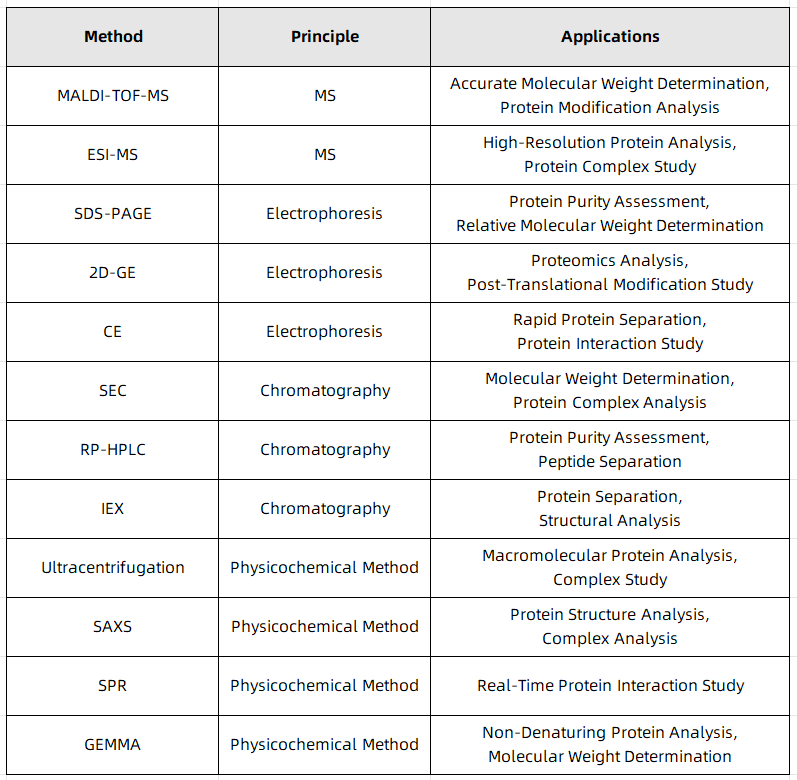12 Proven Ways to Determine Protein Molecular Weight
The molecular weight of a protein is one of its fundamental physicochemical properties and is essential for studying protein structure, function, and biological activity. It is of great significance to accurately determine protein molecular weight in areas such as protein purification, proteomics research, drug development, and genetic engineering. Currently, various methods are available to determine protein molecular weight, each with its own scope of application and advantages. This paper provides a detailed introduction to 12 methods used to determine protein molecular weight and analyzes their principles, advantages, disadvantages, and application scenarios.
The 12 methods to determine protein molecular weight are as follows:
1. SDS-Polyacrylamide Gel Electrophoresis (SDS-PAGE)
2. Capillary Electrophoresis
3. Gel Filtration Chromatography
4. Ultracentrifugation Analysis
5. Osmotic Pressure Measurement
6. Static Light Scattering
7. Liquid Chromatography–Mass Spectrometry (LC-MS)
8. Matrix-Assisted Laser Desorption/Ionization Time-of-Flight Mass Spectrometry (MALDI-TOF MS)
9. Ion Mobility Spectrometry
10. Isoelectric Focusing Electrophoresis
11. X-Ray Crystallography
12. Nuclear Magnetic Resonance (NMR) Spectroscopy
Mass Spectrometry (MS)
1. Matrix-Assisted Laser Desorption/Ionization Time-of-Flight Mass Spectrometry (MALDI-TOF-MS)
MALDI-TOF integrates matrix-assisted laser desorption/ionization (MALDI) with time-of-flight (TOF) mass spectrometry. The protein sample is first mixed with an organic matrix and ionized under laser irradiation. These ions are then accelerated in the flight tube by an electric field, generating distinct signal peaks on the detector based on their mass-to-charge ratio (m/z).
(1) Advantages: Suitable for determining the molecular weight of large proteins; Highly sensitive, enabling detection of low-abundance proteins; Rapid, making it ideal for high-throughput analysis.
(2) Applications: Protein identification; Post-translational modification analysis of proteins; Protein complex analysis.
2. Electrospray Ionization Mass Spectrometry (ESI-MS)
ESI-MS utilizes a high voltage to spray the sample solution, and upon solvent evaporation, charged ions are formed and enter the mass spectrometer for analysis. Compared to MALDI, ESI is particularly suitable for coupling with liquid chromatography (LC), offering more detailed information about proteins.
(1) Advantages: Suitable for proteins in solution; High resolution, capable of distinguishing protein isotopes; Applicable to protein complex analysis.
(2) Applications: Protein-protein interaction studies; Post-translational modification analysis of proteins; Biopharmaceutical analysis.
Electrophoresis
1. Sodium Dodecyl Sulfate-Polyacrylamide Gel Electrophoresis (SDS-PAGE)
SDS denatures the protein and binds to it, imparting a negative charge, which allows the protein to separate in the gel based on its size, thereby enabling the estimation of the protein molecular weight.
(1) Advantages: Low cost, easy to operate; Widely applicable to a variety of proteins; Can be used for protein purity assessment.
(2) Applications: Protein purity assessment; Estimation of protein molecular weight; Analysis of protein composition.
2. Two-Dimensional Gel Electrophoresis (2D-GE)
By combining isoelectric focusing (IEF) and SDS-PAGE, proteins are initially separated according to their isoelectric point (pI), followed by a second separation based on molecular weight.
(1) Advantages: High resolution; Suitable for complex protein mixtures.
(2) Applications: Proteomics research; Analysis of post-translational modifications in proteins.
3. Capillary Electrophoresis (CE)
Proteins migrate within a high-pressure capillary, with proteins of varying molecular weights migrating at different rates, thereby achieving separation.
(1) Advantages: Fast analysis; Small sample requirement; High resolution.
(2) Applications: Protein separation; Protein structure analysis.
Chromatography
1. Size Exclusion Chromatography (SEC)
Using molecular sieving, larger proteins elute first, followed by smaller proteins.
(1) Advantages:Suitable for protein complex analysis; Enables estimation of protein molecular weight.
(2) Applications: Studies on protein aggregation; Protein complex analysis.
2. Reverse-Phase High-Performance Liquid Chromatography (RP-HPLC)
Proteins are separated based on differences in hydrophobicity, and molecular weight is inferred from retention time.
(1) Advantages: High resolution; Suitable for testing protein purity.
(2) Applications: Protein purification; Protein molecular weight determination.
Physicochemical Methods
1. Ultracentrifugation
Proteins sediment at different rates under high-speed rotation, and the sedimentation coefficient can be used to infer molecular weight.
(1) Advantages: Non-destructive; Suitable for large proteins.
(2) Applications: Protein complex studies; Protein aggregation analysis.
2. Small-Angle X-ray Scattering (SAXS)
Proteins in solution are exposed to X-rays, with scattering data used to infer molecular weight.
(1) Advantages: Suitable for proteins in solution; Can reveal protein structural information.
(2) Applications: Protein structure research.
3. Surface Plasmon Resonance (SPR)
Changes in optical signals due to protein-ligand binding allow for estimation of protein molecular weight.
(1) Advantages: No labeling required; Real-time monitoring of protein interactions.
(2) Applications: Protein interaction studies; Drug screening.
4. Gas-Phase Electrophoretic Mobility Measurement (GEMMA)
Protein mobility in the gas phase is measured, which can be used to infer molecular weight.
(1) Advantages: Suitable for native proteins; High precision.
(2) Applications: Protein complex studies.
5. Light Scattering (LS)
Changes in light scattering intensity are measured to calculate protein molecular weight.
(1) Advantages: Suitable for large proteins; Can assess protein aggregation state.
(2) Applications: Protein drug research; Protein complex analysis.
Conclusion

Figure 1
By understanding and utilizing these methods, researchers can select the most appropriate technique for their experiments to obtain reliable data. When choosing a method to determine protein molecular weight, researchers must consider factors such as sample characteristics, experimental requirements, and available laboratory equipment. Each method has its own advantages, limitations, and specific applications, and researchers should select based on their specific experimental needs. MtoZ Biolabs offers high-precision services for determining protein molecular weight, helping researchers obtain accurate data quickly and providing one-stop solutions for fields such as biomedicine and protein research.
MtoZ Biolabs, an integrated chromatography and mass spectrometry (MS) services provider.
Related Services
How to order?







